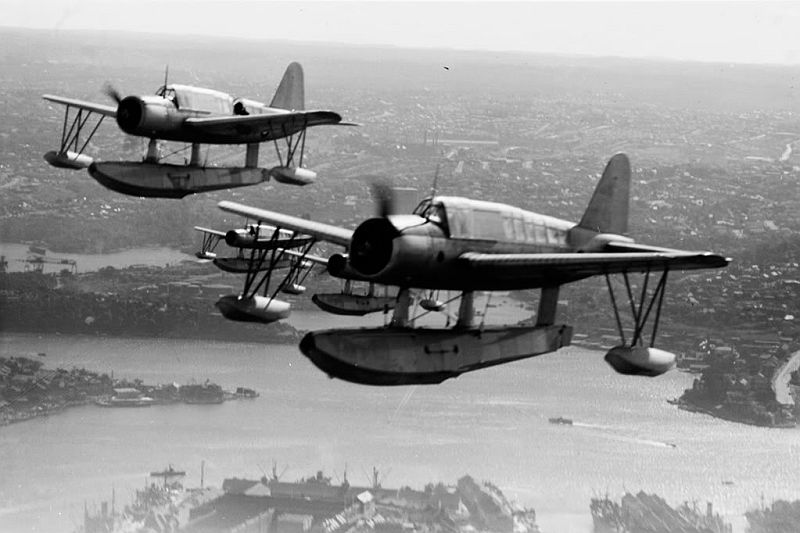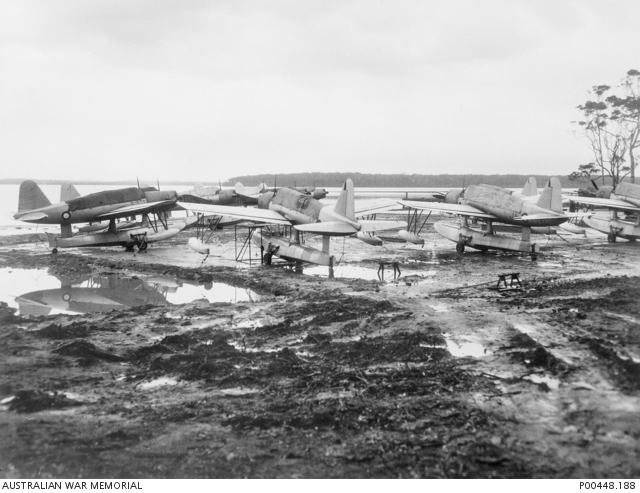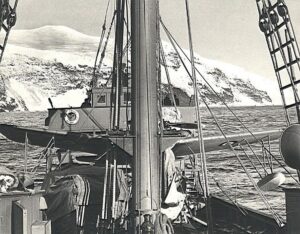- Author
- Editorial Staff
- Subjects
- WWII operations, History - WW2, Aviation
- Tags
-
- RAN Ships
- HMAS Albatross (Shore Establishment)
- Publication
- December 2023 edition of the Naval Historical Review (all rights reserved)
There is a fascinating small book by Barry Pattison titled Kingfishers in the Antipodes which was published in 1998 and later serialised in News & Views, the magazine of the International Plastic Modellers Society of New South Wales. Much of the information in this article comes from these sources, with assistance from our friends at the Fleet Air Arm Museum at HMAS Albatross.
Surface Raiders and Submarines
Early in WWII the commerce raiders Orion, Komet, Pinguin and Kormoran left Germany disguised as neutral freighters and waged a deadly war in the South Seas, sinking or capturing 62 ships. Orion and Komet hunted in the South Pacific and mined New Zealand waters, Pinguin raided in the Indian Ocean before mining the approaches to Australian ports and capturing the Norwegian whaling fleet in Antarctica. And Kormoran will forever be remembered for sinking the cruiser HMAS Sydney off Western Australia.
Japanese submarines first came to our shores in May 1942 when a squadron of five large ocean-going submarines I-21, I-22, I-24, I-27 and I-29 stood off the NSW coast. A floatplane reconnaissance was conducted over Sydney on 23 May with a follow-up flight over both Sydney and Newcastle on 30 May. This led to the well-known midget submarine attack on Sydney on 30 May/1 June and subsequent shelling of Newcastle on 8 June 1942.
In total, between 1942 and 1943 fourteen (14) Japanese submarines entered Australian waters and were involved in over 40 attacks upon shipping; of these 19 ships were sunk. Of particular note is the patrol of the submarine I-11 on 20 July 1942 when she torpedoed and sank the Greek freighter George S Livanos sailing from Melbourne with a cargo of Army vehicles built locally by Ford and General Motors. This cargo was destined for Sydney when she was sunk 20 miles off Jervis Bay. Just three hours later I-11 came across the American freighter Coast Farmer which was similarly dispatched. I-11 continued south and one day later sank another American Liberty ship William Dawes off Twofold Bay.
These incidents were poorly handled. After the attack on Sydney and Newcastle there was an apparent lull in submarine activity causing the Australian Naval Board to dispense with coastal convoys on 15 July 1942. Just five days later I-11 made her first kill and after three ships had been sunk convoys were reintroduced on 21 July. Seemingly there were also no Australian aircraft available to assist as the USAAF operating from Nowra sent out Marauders to search unsuccessfully for the submarines.
Four German U-boats were assigned to operate in Australian waters in 1944. These boats, U-168, U-196, U-537 and U-862 based in the Japanese occupied Netherlands East Indies, had minimal impact on the war effort. Details of the departure from Djakarta of both U-168 and U-537 were intercepted by the Allies. As a result U-168 was sunk by the Dutch submarine Zwaadvish on 6 October 1944 and U-537 sunk by the American submarine USS Flounder on 6 November 1944. U-196 sailed from Djakarta on 30 November 1944 and is believed to have sunk following an accident a few days later in the Sunda Strait.
U-862 was the only boat to make a successful foray into Australian waters. In her first engagement on 9 December 1944, in rough seas south of Adelaide she attacked the Greek steamer Illisos by gunfire. As Illisos bravely returned fire the submarine broke off the attack. With poor results sailing around Tasmania she found the American Liberty ship Robert J Walker on Christmas Eve 1944, right on our own doorstep off the NSW coast near Moruya. The first RAAF aircraft came on the scene ten minutes after the last torpedo exploded sending the ship to the bottom. This then led to amassive submarine hunt extending over a fortnight involving aircraft and RAN and USN ships but U-862 had escaped. She was to make three further unsuccessful attacks including off the east coast of New Zealand, before sinking one more freighter, Peter Sylvester, off the Western Australian coast and returning to Djakarta on 15 February 1945.

The above illustrated a need for maritime surveillance, which at times was demonstrably inadequate over the vast Australian coastline. This requirement was ably supplemented by the Kingfishers.
The Kingfishers
The Kingfisher floatplanes acquired by the RAAF started as an order which was placed by the Netherlands East Indies (NEI) Naval Air Services with the American manufacturer Vought-Sikorsky, for 24 of their OS2U, floatplanes. The manufacturer’s records show they were accepted on 31 December 1941, partially disassembled and loaded aboard Dutch ships Tabian (seven aircraft), Mapia (10 aircraft) and Welterveden (seven aircraft). These ships sailed from New York on 18 January 1942 bound for Java. During the voyage Singapore fell to the Japanese and with the NEI in grave danger the convoy was re-routed to Australia. On arrival 18 aircraft were allocated to the RAAF and three to the USAAF, the latter being repositioned in New Caledonia. The remaining three aircraft mysteriously disappeared from records.
RAAF Service
The first seven aircraft arrived at the large RAAF seaplane base at Rathmines on the mid north coast of New South Wales on 22 April, with the remainder going to the major RAAF base at Point Cook in Victoria on 6 May 1942. The Point Cook aircraft were subsequently ferried to Rathmines in late 1942/early 1943.
The Kingfishers were given a RAAF designator A48, with serial numbers running from A48-01 to A48-18. Originally painted in USN camouflage with NEI insignia, this was changed to RAAF insignia. Later on they were repainted in a darker camouflage, more suited to operations in south east Australia, but the external paintwork was later removed, taking the aircraft back to bare metal. This gave an increased in speed of 6 knots and less drag during take-off. Some minor modifications were made to the aircraft’s gun sights and the rudder assembly. And with armour removed the aircraft later had an increase in its weapons payload from 2 x 100-pound depth charges to 2 x 250-pound depth charges. While officially known as Vought-Sikorsky in October 1943 the manufacturer changed the name of these aircraft to ‘Kingfisher’.
Rathmines
An RAAF station was first established at Rathmines in the late 1930s at Lake Macquarie which is south of the strategically important coal and steelmaking centre of Newcastle. First used for flying training and search and rescue, in December 1939 it became home to a Seaplane Training Flight equipped with Seagull V amphibians. The Seagull (in naval terms Walrus) had originally been intended for the RAN to complement the seaplane carrier HMAS Albatross, and for use on cruisers, where they could be catapulted off for reconnaissance. They were initially based at the old colonial naval headquarters at Rushcutters Bay. With major cutbacks in the Great Depression the Seagulls became part of a Fleet Co-operation Flight with the aircraft maintained and manned by RAAF crews, except for Naval Observers (Navigators) and Naval Telegraphists/Air Gunners.
With the later arrival at Rathmines of the Kingfishers, this became known as No 3 Operational Training Unit (OTU), preparing crews for conversion to the much larger Catalina flying boats which first started to arrive in February 1941.
The Kingfishers and associated personnel formed No 107 Squadron on 3 December 1942, but were almost immediately reattached to No 3 OTU. The squadron again separated from No 3 OTU on 22 March 1943 and was declared operational on 10 May 1943.
Nowra Air Base
A civilian airfield had been established at Nowra in the early 1930s which was identified for potential wartime defence use. The RAAF took control of the airport in August 1940 and work on expansion began in July 1941.
In early 1942 units from the NEI Air Force displaced from Java were temporarily accommodated at Nowra and B-26 Marauders (medium bombers) of the USAAC arrived in May 1942, shortly to be joined by Australian Beaufort bombers.
The base was later considered an ideal location for Royal Navy Fleet Air Arm units attached to the British Pacific Fleet and on 2 January 1945 it became HMS Nabbington. With the post war departure of the BPF, Nabbington decommissioned on 15 November 1945. The base recommissioned as HMAS Albatross, also known as Naval Air Station Nowra, on 31 August 1948, following the formation of the RAN Fleet Air Arm the previous year.
St George’s Basin
Overcrowding at Rathmines and the competing priorities of both training and operational units subsequently led to the decision to move 107 Squadron south of Sydney, in a location still suitable for protecting coastal shipping against submarine attack. A site was selected at St George’s Basin and work commenced constructing new facilities involving building a slipway, hangers and accommodation in virgin bush on the western shores of the Basin.
With final preparations made on 30 June 1944 No. 107 Squadron’s 15 Kingfishers flew in formation from Rathmines to St George’s Basin. The new base was now home to 27 officers and 163 airmen plus all their associated equipment. After the relative comforts of Rathmines conditions at the Basin were spartan, and during the first year made all the more difficult by an abnormally wet winter with crews having to contend with mud and slush. One bonus of the move south was that the less congested waterway at St George’s Basin allowed for shorter taxi times and thus more time on patrol.

The squadron was mainly involved in anti-submarine patrols, which continued until the end of the war despite a total lack of submarine sightings. The first loss of a Kingfisher, A48-08, occurred on 14 January 1943 when on anti-submarine patrol 40 miles off Sydney. While shadowing an American Liberty ship Henry Dearborn, the aircraft suffered an engine failure. It crash-landed and sank but luckily the crew was saved by the merchant ship. Although a robust and reliable aircraft, the RAAF did lose a number of other Kingfishers. In one alarming incident during gunnery practice a round exploded in the breech causing a cockpit fire. The pilot made a forced landing at sea and the aircraft capsized. The crew escaped but the aircraft was lost while being towed ashore.
Two other aircraft were lost while operating at St George’s Basin. On 4 October 1944, A48-10 crashed off Jervis Bay with the loss of her crew. Two other aircraft were lost while operating at St George’s Basin. On 4 October 1944, N48-10 crash landed off Jervis Bay and on 1 May 1945, N48-01 capsized while coming in to moor at the Basin, due to what was believed to be a flooded float. While the aircraft was recovered it was deemed unrepairable and converted to spares.
The previously mentioned sinking of Robert J Walker south of Jervis Bay by U‑862 resulted in a week of high tempo activity for 107 Squadron. It was to fly five sorties per day and during this period conducted the squadron’s only deliberate attack of the war, dropping depth charges on what was believed to be a periscope. While the aircrew reported seeing an oil slick, post war records reveal U-862 was well on her way to New Zealand. On Christmas Day a patrolling Kingfisher suffered an engine failure and safely conducted a forced landing on the Moruya River. On Boxing Day, a fuel problem led to another Kingfisher putting down in Wreck Bay and subsequently taxiing over the bar and up Sussex Inlet, back to base at the Basin.
Although not assigned for Search and Rescue (SAR) missions, the arrival of the Royal Navy task force in the area led to a spate of SAR missions. The first of these was the rescue of a Royal Navy Corsair pilot, who had ditched his aircraft in the south of the Basin on 24 February 1945. A Kingfisher who saw the crash landed adjacent to the aircraft and recovered the pilot who was subsequently transferred to a crash rescue boat.

With enemy submarines now few and far between the squadron ceased operational flying on 9 August 1945 and the remaining aircraft were flown to the Flying Boat Repair Base at Lake Boga in Victoria awaiting dispersal. During its time at St George’s Basin, No. 107 Squadron Kingfishers flew over 4000 hours on anti-submarine patrols, convoy escort, SAR and other duties. The Squadron was disbanded on 31 October 1945In 1947 most of the aircraft were offered for sale and many were dismantled for spares. None are now known to be in existence except for a fuselage held at the Warbirds Aviation Museum at Mildura which is not far from Lake Boga. In 2006 the remains of this aircraft were obtained by Precision Aerospace and rehoused at the Old Air World hangar, Wangaratta.
Australian Antarctic Expedition 1947/48
One late foray of the Kingfisher came in 1948 when a Kingfisher in a coat of high visibility yellow paint was embarked in HMAS Wyatt Earp on her Antarctic expedition. Wyatt Earp was far past her prime and many would say unsuited to this task but go she did down into the ice and returned safely. The Kingfisher which had to be disembarked and recovered using the ship’s derrick flew for a total of 55 hours with much invaluable service guiding the ship through the ice pack. A second Kingfisher was also refurbished for this role and held ashore in reserve, but, was not needed.
And so ends the story of the valiant Kingfishers of St George’s Basin, which for a short period was alive with the roar of floatplanes taking off and landing on its tranquil waters. There is little other evidence left of these times.
References:
Gill, Hermon G., Australia in the War of 1939-1945 Vol II Royal Australian Navy, Australian War Memorial, Canberra 1968.
Pattison, Barry, Kingfishers in the Antipodes, Red Roo Models, Melbourne, 1998.
Pattison, Barry, Kingfishers in the Antipodes, News & Views Vol 12/1-2, International Plastic Modellers Society of New South Wales.
Reid, Richard, Australia Under Attack, Department of Veterans’ Affairs, Canberra, 2000.
Robinson, Stephen, False Flags, Exisle Publishing, Wollombi, NSW, 2016.
Roylance, Derek, Air Base Richmond, Published by RAAF Base Richmond, 1991.




